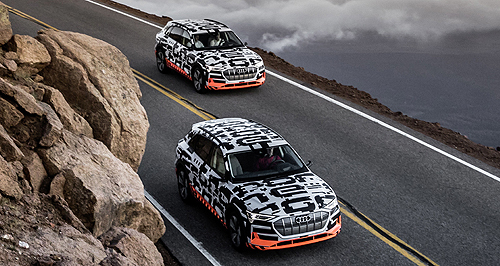Future models - Audi - e-TronAudi confirms e-tron powertrain detailsUp to 300kW/664Nm on offer via overboost in Audi’s e-tron battery-electric SUV9 Aug 2018 AUDI has confirmed powertrain details for its first battery-electric vehicle (BEV), the e-tron SUV, which produces up to 300kW of power and 664Nm of torque – but only for eight seconds at a time.
The maximum system outputs of the e-tron’s two electric motors are temporarily achieved when the automatic transmission is shifted across to Sport and the accelerator is fully depressed, which then activates Boost Mode.
As a result, the German marque claims the e-tron can sprint from standstill to 100km/h “in less than six seconds” – just quick enough to beat the limited overboost time frame – while on the way to its top speed of 200km/h.
In all other scenarios, the e-tron develops 265kW and 561Nm, with the latter figure available almost instantly, but peak performance without output losses can only be delivered for up to 60 combined seconds. It is currently unclear when this time period resets.
On the strict WLTP testing cycle, the e-tron offers more than 400km of driving range, of which 30 per cent is thanks to energy recuperation via its electric motors and electro-hydraulically integrated brake control system.
The e-tron recuperates up to 220kW and 300Nm of energy, which is more than 70 per cent of its operating energy input – the highest value for a series production model to date.
Specifically, three different energy recuperation modes work together to achieve this efficiency, including manual coasting using paddle shifters, automatic coasting via Efficiency Assist, and brakes with transition between electric and hydraulic deceleration.
At up to 0.3g of g-force, the e-tron forgoes traditional brakes and recuperates energy using only its electric motors, which are responsible for more than 90 per cent of its decelerations. This process ensures that all braking manoeuvres recharge the battery pack while on the move.
The driver can choose between three levels of energy recuperation using coasting, with the lowest ensuring there is no additional drag torque when the accelerator is released, while the highest slows the vehicle down at such a pace that the wheel brakes are not required to come to a complete stop.
However, the wheel brakes are used when the driver decelerates by more than 0.3g using the brake pedal, with them responding “extremely quickly”, thanks to what Audi claims is a world-first for a series production model with electric drive.
According to the brand, “a hydraulic piston in the compact brake module generates additional pressure and, thus, additional brake force for the recuperation torque”, which helps to reduce braking distance by up to 20 per cent when compared with a conventional set-up.
Depending on the driving scenario, the aforementioned electro-hydraulically integrated brake control system decides if the e-tron and its individual axles will decelerate via the electric motors, wheel brakes, or a combination of the two.
While the brake pedal is decoupled from the hydraulic system, the transition between the latter and electric deceleration is imperceptible to the driver, according to Audi.
Efficiency Assist is standard and uses radar sensors, camera images, navigation data and vehicle-to-infrastructure (V2X) communication to determine the traffic conditions and the route, with the driver encouraged by the digital instrument cluster to take their foot off the accelerator when appropriate.
Furthermore, when adaptive cruise control with stop and go functionality is optioned, Efficiency Assist can predict when to accelerate or decelerate the e-tron.
In order to prove the e-tron’s efficiency, the car-maker took several prototypes to Pikes Peak in the Rocky Mountains near Colorado Springs, Colorado. Their 31km downhill drive saw enough energy recuperated to allow them to cover about the same distance again.
As previously reported, the e-tron will arrive in Australian showrooms next year, likely during the second half. Pricing and full specifications will be released closer to its launch.  Read more5th of July 2018  Audi reveals futuristic e-tron interiorConcept-like Audi e-tron interior sees cameras replace traditional side mirrors23rd of April 2018  Audi details e-tron driving range, charging timesLess than 30 minutes required to fully charge pure-electric Audi e-tron SUV16th of March 2018  Audi’s next all-electric model revealed as e-tron GTFlagship sporty sedan to follow Audi e-tron SUV and Sportback from around 20207th of March 2018  Geneva show: Audi reveals all-electric prototypeNew e-tron prototype to preview Audi’s first pure-electric production vehicle19th of April 2017  Shanghai show: Audi lights up with E-tron SportbackProduction version of Audi’s E-tron Sportback concept confirmed for 2019 |
Click to shareAudi modelsResearch Audi Motor industry news |
















Facebook Twitter Instagram